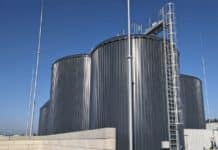The Russian power industry policy, both present and past, has been based on the production and export of fossil fuels – crude oil and gas. Despite the huge raw material potential (763.5 million hectares of forested areas), cautious estimates considered, biomass generates as little as ca. 1% (9 TWh) of domestic power annually. The lack of government initiatives regarding development of the biomass industry is countered by a dynamic development of the pellet market produced by big wood processing plants.
According to the assumptions made by the government, by 2020 Russia should improve its energy efficiency by ca. 40%. Renewable sources are planned to be included in this plan, although development of the RES market is not prioritized by the authorities. Nevertheless, recent years have shown a growing number of projects aimed at enterprises that produce green energy, such as pulp mills, biogas plants processing agricultural waste as well as plants producing pellets and rape for export. The assumptions of the Russian programme to improve energy efficiency include, i.a. construction of biomass power plants with the total power output of 580 MWh and agricultural biogas plants generating 330 MWh of electricity1, yet the experts do not think that the industry will grow dynamically. For the time being, only the sectors of solar, wind and water power may count on financing from the government. The projects utilizing biomass or biogas are usually developed by authorities of particular areas, such as Vologda Oblast, where Beliy Ruchey, a 6 MW biomass power station, is operated, or in Syktyvkar, where a 4 MW wood biomass-fired combined cycle plant is located. In 2012-2013, two Russian corporations – Gas Energo Stroy and Biogas Energo Stroy – presented an ambitious plan to build 50 biogas power plants in 27 regions of the country, so far only 4 of the projects have been completed, which is undoubtedly connected with the lack of country-wide governmental programme that would stimulate development of this sector.
Forestry industry potential
The Russian Forestry Agency calculated that the annual amount of wood waste from clearing and thinning of forests is ca. 8 trillion tonnes, out of which only 8 million m3 of waste wood that does not come from private enterprises is used for biofuels production. Experts claim that development of this branch of industry is hindered by a limited access to professional equipment and modern technologies used for obtaining forestry biomass, lack of support from the government and insufficient knowledge of raw materials processing. The possibilities are vast, the fuel wood resources in Russia have been estimated at ca. 90 million m3, which includes: 51 million m3 of fireplace wood, 15 million m3 of stumps and logs, 12.7 million m3 of timber mill waste, 4.1 million m3 of post-production waste from plywood production and 4.2 million m3 of waste from the pulp and paper industry2.
The pellet market is currently the fastest growing branch of RES in Russia, admittedly a relatively fresh one, but already successful and with an even greater potential. The country ranks 3rd (following the USA and Canada) in export of raw materials and 8th in the world ranking of countries producing wood pellets. The biggest manufacturing plants are Vyborgskaya Cellulose (400 k tonnes per year), SP Arkaim (70 k tonnes per year), Arkhangelsk-based JCS “LDK3” (50 k tonnes per year) and JSC “Lesozavod-25” (63 k tonnes per year)1. 2015 data of the governmental statistical agency Rosstat indicate 978 k tonnes of the manufactured pellets, yet it is pretty certain that this number is understated, since it does not include medium and small manufacturing plants constituting parts of big facilities in the timber mill and wood industry. The Russian Ministry of Energy estimates that production will grow by 10-15% annually. Such a prognosis stems from a series of pellets-related investments that are about to be completed or are just being launched. The portal Lesonline.ru presents the market situation quite precisely – ca. 50% of pellets production is domestically handled by nearly 20 facilities manufacturing from 30 to 70 k raw materials per year. The potential of smaller plants is on the rise; today they produce ca. 14% of pellets, but their significance on domestic markets is expected to intensify. A considerable amount of pellets exported outside the country is EN plus-certified – in 2016 only 16 pellet manufacturing plants were successful in obtaining the EN-plus certificate, since 2015 eight manufacturers were awarded the SPB certificate related to industrial pellets.
In theory, the raw material potential in agricultural, food and communal waste allows Russia to produce 66 trillion m3 of biogas and 122 million MT of high-quality granulated fertilizer. Experts estimate the Russian RES market to be worth close to USD 20 trillion.
Bright horizon
Despite the lack of policy clearly aimed at development of green energy, this market will surely grow in Russia. To a smaller extent, it will result from worldwide trends supporting development of RES systems or limiting the emissions of national industries. What is significantly more important is the economic aspect of the green business. Although Russia is not likely to compete with western and Asian countries in “green technologies”, its powerful raw materials stocks allow to make a prediction that the country will become one of the main exporters of pellets worldwide. Things still to be dealt with: the lack of national quality standards covering the produced biofuels, poor road infrastructure, the lack of logistics centres and storage capacity and (still) the seasonal nature of the market.
References:
1. USDA Foreign Agricultural Service, Report Russian Federation: Biofuels Annual. Biofuels Update, June 2016.
2. Bioenergy International, World of Pellets 2015.
Newsletter
Bądź na bieżąco z branżą OZE



![Kongres Biogazu: Jak pobudzić rozwój rynku biogazu?[RELACJA I ZDJĘCIA] 9. Kongres Biogazu, Magazyn Biomasa](https://magazynbiomasa.pl/wp-content/uploads/2024/12/9.-Kongres-Biogazu-Magazyn-Biomasa.19-218x150.jpg)

























![Kongres Biogazu: Jak pobudzić rozwój rynku biogazu?[RELACJA I ZDJĘCIA] 9. Kongres Biogazu, Magazyn Biomasa](https://magazynbiomasa.pl/wp-content/uploads/2024/12/9.-Kongres-Biogazu-Magazyn-Biomasa.19-324x160.jpg)












